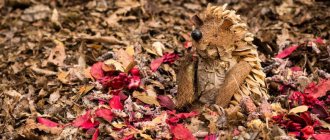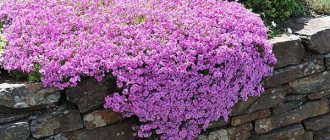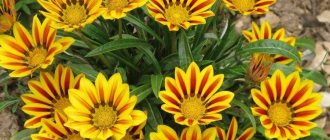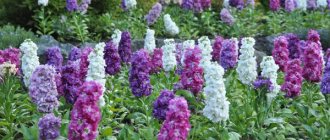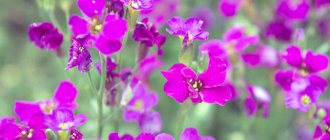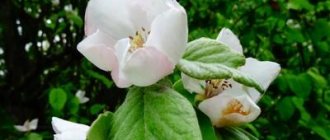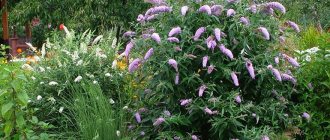Clarkia is an annual shrub from the fireweed family, which is sometimes combined with the genus Godetius. The stems of the plant are branched and reach a length of 0.3-1 m, depending on the species. The lower part becomes lignified by the end of the growing season. Clarkia blooms almost all summer with colorful four-petaled flowers.
This flower crop is very popular among gardeners. Due to its attractiveness, it is successfully used to decorate flower beds, borders, open balconies and other places. Clarkia is easy to care for. It is easy to grow either by seedlings or by sowing seeds directly into open ground.
Types and varieties of clarkia for open ground
The plant is native to the western part of North America, Chile. Clarkia was brought to Europe from California in the 19th century by Captain William Clark, after whom it was named. Sometimes the flower is also called “California marigold.” In nature there are about 30 varieties of it. But only some types of clarkia are used for home cultivation.
Graceful
Shrub up to 1 m high. The leaf blades are oval in shape and have reddish veins. The flowers come in single and double varieties in different shades. Flowering occurs from July to September.
Popular varieties:
- Albatross is a low-growing plant up to 0.7 m, with white double flowers.
- Salmon Perfection is a loose-shaped shrub up to 0.9 m high. The flowers are double, salmon-pink in color.
- Terry is a low shrub with large double flowers collected in spike-shaped inflorescences.
- Sakura is tall and has double flowers of a creamy pink hue.
Pretty
A dwarf variety with straight stems up to 0.4 m high, narrow and long leaves. The petals are thin, trilobed, which is why this species is also called “trident”. It blooms from July to September with pink, lavender or bright crimson flowers.
Brevery
Cold-resistant clarkia up to 0.5 m high. Small flowers are collected in loose inflorescences. They look like butterflies. The aroma of this species is much stronger than that of other clarks. The most popular variety is Pink Ribbon, which has pink flowers with ribbon-like petals.
general information
Clarkia is a herbaceous annual, close in origin and essence to godetia. Several centuries ago, a certain Captain Clark brought this beautiful flower to Europe from the North American coast. In the garden, clarkia grows in charming islands, densely covered with axillary flowers of a simple or double type.
The height of Clarkia ranges from 30 to 90 cm. It has very thin and often pubescent shoots, oval sessile leaves and loose apical inflorescences in the form of a brush or spikelet. The diameter of each individual flower reaches 3.5 cm.
Photo: mainavi.ru
Growing from seeds to seedlings
These flowers can only be grown from seeds - in seedlings and without seedlings. To achieve earlier flowering, many people prefer to sow seeds for seedlings in advance.
Sowing time
From the beginning of the growing season to flowering, Clarkia takes about 2 months. Taking this into account, you need to plan the time of sowing seeds for seedlings. To get flowers at the beginning of summer, it is better to sow no later than the first half of March. In some cases it is shifted to the end of February. Seedlings are planted in open ground when the soil is well warmed up so that there is minimal risk of bacterial diseases of the roots. The best period for this is the second half of May. In the southern regions you can do this earlier.
Planting container and soil
Seedlings can be grown in peat cups or in ordinary boxes. Young plants are not afraid of transplants. You can sow in special pots, which, together with adult flowers, will be taken out into the garden or open veranda.
The soil for clarkia should be loose and nutritious with a slightly acidic reaction. If it is heavy, the flower will not be able to develop normally. The best option for the plant is a substrate made from equal parts of leaf soil, peat, sand, and rotted humus. To prevent the future development of fungal and bacterial infections in the crop, it is recommended to steam or calcine the soil in the oven before use.
Seed preparation and sowing
Before sowing, it is recommended to keep the seeds in a solution of potassium permanganate for some time. This is necessary not only for disinfection, but also to ensure that they are not spoiled by pests. Fill the container with soil and level it. Scatter the seeds on top. Slightly deepen them into the soil by 1.5-2 cm, sprinkle with warm water from a spray bottle. Cover the top with glass or film to create a mini-greenhouse. Move the “bed” to a warm place, cover it from direct sun. The room should be well ventilated and dry.
How to care for seedlings
Shoots will appear in 1.5-2 weeks. After germination of the seeds, the glass or film can be removed and the box moved to a more illuminated place. Seedlings need to be watered regularly, but not abundantly. The soil should always remain slightly moist. Seedlings can be sprayed with water. Clarkia grows well at a temperature of +25-27 degrees. When the seedlings reach 15 cm in height, they can be pinched. This will make it more branchy and powerful. But some hybrids do not dive; they do not tolerate transplantation. In such cases, the plants are carefully thinned out so as not to injure neighboring seedlings.
Planting seedlings in open ground
Planting seedlings should be planned as early as possible. It is recommended to prepare the area for transplantation 2 weeks before the procedure. Dig up the soil and fertilize with potassium sulfate and superphosphate (1.5 spoons per 1 square meter), and peat. If the soil is acidic, sprinkle dolomite flour on top, if alkaline, sprinkle with a solution of citric acid.
It is better to replant seedlings in groups of seedlings together with a lump of earth. The distance between each group should be about 20-40 cm. Do not bury the root collars. They should be level with the soil surface. Near the flowers, strengthen the supports on which the growing stems will curl.
How is it different from godetia?
Clarkia is very similar to godetia, the similarity is so strong that some botanists even considered these crops to be a variety of the same plant for a long time. However, these are different cultures.
Claricia's flowers are small, looking like miniature roses, as if strung on twig stems. Godetia's flowers are quite large, elegant, satiny - each size is 6-8 cm, they can be double or simple. Both cultures can have a wide variety of shades: white, pink, as well as scarlet, purple, lilac and bluish.
The height of the bush also varies. Clarkia grows up to 30–90 cm, while the length of the Godetia stem does not exceed 30–40 cm.
Despite their differences, gardeners often plant these plants together. They claim that the cultures harmoniously complement each other in the flowerbed.
Planting seeds without seedlings in open ground
If you don’t have the time or desire to grow seedlings, you can sow the seeds directly into open ground. This method guarantees stronger and healthier shoots. But clarkia blooms in such cases later than from seedlings.
Rules and terms
Seeds can be sown in well-warmed soil, when there is no longer a risk of sudden temperature changes. Otherwise, the sprouts that have not yet matured may freeze and die. Usually sowings are planned for the first half of May. But if the climate and weather permits, you can move them to the end of April. Sometimes sowing is carried out in the fall so that seedlings appear in early spring.
Choice of location and lighting
Like seedlings, the seeds themselves need to be sown, choosing a place in advance. Clarkia, unlike many other plants, can grow not only in well-lit areas, but also in partial shade. She is also not afraid of drafts. More soil requirements. When choosing a location, it is taken into account how the culture will fit into the overall landscape.
Soil
The soil should be fertile and light. If it does not meet the requirements on the site, some adjustments will have to be made. If the soil is dense and clayey, you need to dig it up, add sand and peat. It is loosened to ensure free access of oxygen to the roots and to avoid stagnation of moisture. You need to prepare the soil and add the necessary compounds to it 2 weeks before planting.
Landing Features
For sowing, holes (nests) are made in the selected area at a distance of 25-40 cm from each other. If the variety is tall, the distance is increased by 20-30 cm. 4-5 seeds are thrown into each nest. Can be sown in rows. But then the young shoots will have to be thinned out.
What diseases do they face?
This plant is quite resistant and invulnerable to disease. But if there are errors in care or cultivation, certain diseases may develop. If the bush is planted on loamy soil, this can provoke the development of rust. This fungal disease also appears when liquid stagnates in the soil. To get rid of rust, fungicidal preparations are used.
If there is stagnation of moisture in the roots, downy mildew may develop. In this case, fungicides are used to treat the plant.
Outdoor care
Cultivation of clarkia in open ground does not differ from the seed and seedling planting method. Timely watering, fertilizing, and preventing pests are important for the flower.
Watering
The amount and frequency of watering is affected by the weather that will occur during the plant’s growth.
If the summer is cool and it rains often, then there may be no need for watering at all. In other cases, it is necessary to moisten the soil when the top layer dries. On a note! If the clarkia is too saturated with moisture, this will lead to rotting of the roots. To avoid this, after each watering the soil should be loosened near the bush. You need to water the plant in the morning or evening, when there is no scorching sun. It is important to avoid getting water on the flowers, as this can have a bad effect on the appearance of the crop.
Top dressing
Fertilize flowers 1-2 times a month. Complex fertilizers for flowering plants are effective on Clarkia:
- Nitroammofoska – 15 g per 1m2 during budding;
- Kalifos-N – 20-25 g per 1m2;
- Diamofoska – 2 g per 1 liter of water during the period of intensive growth.
Sometimes a solution of chicken manure (1:15) is used. It is applied at the beginning of the growing season.
Trimming
If clarkia grows densely, it needs to be thinned out so that the bushes have room to develop. There should be at least 15-20 cm between plants. But you shouldn’t thin them out too much so that there are no voids left. When the plant fades, its stems are cut back to the soil. Remains of roots are removed when digging up the area. It is better to burn them to prevent the development of pathogenic bacteria or fungi that can infect the soil.
Flowering (how to extend flowering time)
With the seedling planting method, flower stalks may appear as early as late May or early June. When sowing in open ground - a little later. Clakyria can bloom until autumn. If you want to prolong flowering as long as possible, you need to adhere to certain conditions. Tillering of sprouts promotes abundant flowering. When the seedlings grow to 10 cm in length, you need to carefully pinch off the top. This stimulates budding and abundant flowering. After the flower stalks fade, they need to be removed.
Features of feeding
Fertilizers must be applied at the time when buds begin to form and when active flowering begins. It is recommended to use mineral compositions for feeding. Do not use organic types of fertilizers.
Fertilizing is applied during dry periods. To enhance the brightness of the flowers and extend the budding period, it is recommended to add wood ash.
Seed collection and wintering
You need to determine in advance which flower stalks to leave for the seeds to ripen. There is no need to delete them. The grains appear after pollination of the ovary. They ripen in small oblong boxes. 1 g can contain up to 3,000 seeds. They ripen approximately a month after flowering ends. When the seed pods turn brown, the seeds are ready to be collected. It is recommended to place a fabric bag on the seed pod in advance to prevent self-seeding into the ground.
The seeds are additionally dried for several days, then stored in paper bags in a dry, cool room. After 3-4 years, the seed loses its quality and germination rate decreases. Therefore, it is better to use fresh seeds for sowing.
Description of the flower
The flower grows no more than 85-95 cm. The shoots with this growth are erect, very branched due to the formation of new stems from the lateral axils. Slight pubescence is often observed on the shoots. The edge has small fine fibers. The leaves are green, with a bluish tint. They are located alternately on the shoot. The shape of each leaf is a slightly elongated oval.
Flowers are formed from the axils of the leaves, which can be either simple or double. When opened, each flower is up to 3-4 cm in diameter. The petals have a very different color: from snow-white to burgundy shades. The inflorescence is formed mainly at the top of the shoot. The flower consists of a tubular calyx and four-lobed petals, of which there can be four or three on one flower.
If the clarkia is double, then there are many such petals. When flowering, the aroma spreads throughout the area, attracting insects for pollination. As a result of pollination, very small seeds are formed, located in a capsule.
After planting the seeds, the plant will bloom in two months. Typically flowering lasts one and a half to two months.
Diseases and pests, control methods
Clarkia is characterized by stable immunity. Therefore, it is rarely exposed to diseases and pest invasions. But sometimes it can be affected by fungal infections. They are usually associated with excess moisture and frequent watering. First, the roots are damaged, and the entire plant gradually withers. In such cases, it is almost impossible to save the flower. It is recommended to simply remove damaged specimens and adjust the watering system.
To prevent infection of other plants, it is recommended to treat them with the following means:
- Oksikhom,
- Bordeaux mixture,
- copper sulfate.
Pests that damage clarkia:
- mealybug;
- garden flea beetle.
To combat parasites, spraying with fungicides is used:
- Karbofos;
- Fitoverm;
- Confidor.
Combination with other plants (Clarkia in landscape design)
Thanks to its unpretentiousness and abundant flowering, Clarkia deserves a place of honor in landscape design.
Scope of application:
- in flower beds, along fences, alleys, fences;
- in pots on balconies, window sills, on walls (low-growing varieties);
- in bouquets with other flowers (tall varieties).
In addition, its flowers have a beautiful aroma and are a good peduncle. It goes well with other low plants:
- lilies;
- phlox;
- asters;
- white daisies;
- Red roses.
Clarkia is a very popular crop for growing in open ground. Caring for it does not require much effort. The flower reproduces well both by seedlings and without seedlings. It can grow almost anywhere, even in partial shade and drafts. The main thing is to provide it with suitable soil and regulate the moisture level.
More useful information about growing clarkia from sowing to collecting seeds can be found in the video:
Preventing shoots from freezing
Failure to follow the recommendations on when to plant clarkia in an outdoor garden bed will most likely lead to the freezing and death of still rather weak plants. Most often, such crops are planned for the first weeks of May.
However, if the climatic conditions of a particular geographic latitude allow one to count on a consistently warm spring, then seed planting can be planned for the end of April.
In some cases, gardeners, reproducing the natural conditions of the growing season, carry out sowing work in the autumn, which allows them to obtain seedlings in early spring.
